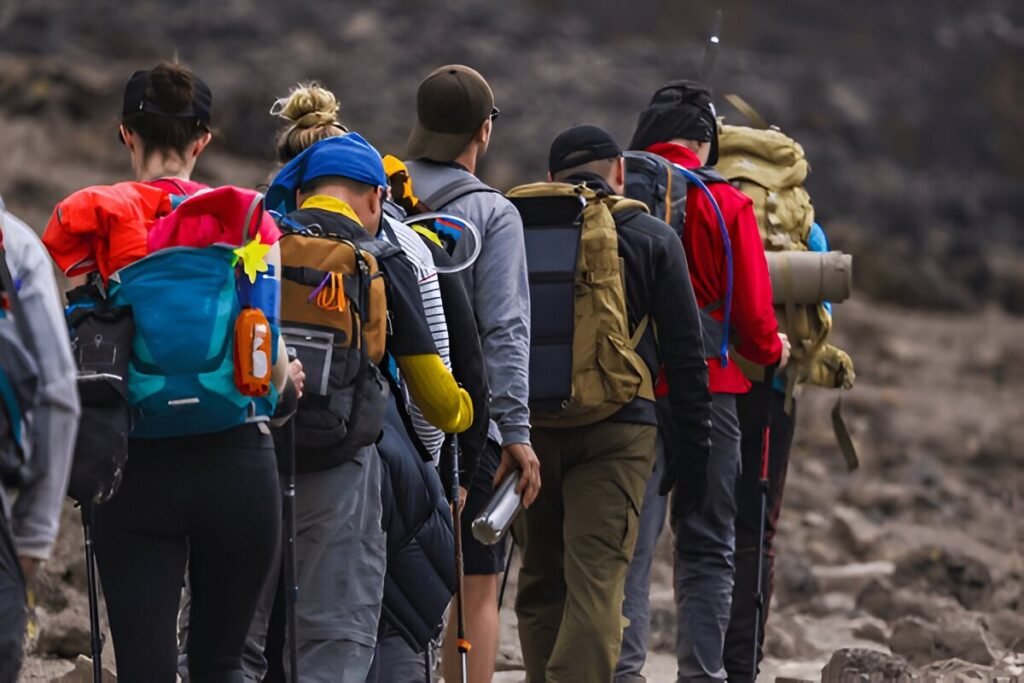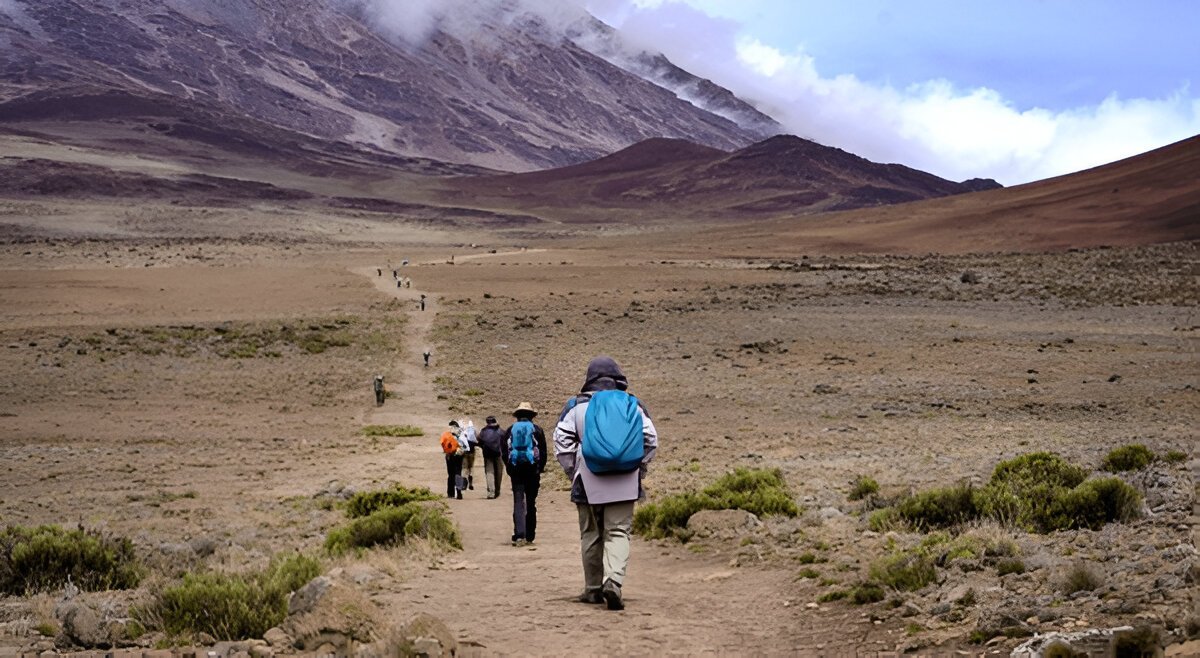Climbing Mount Kilimanjaro is a dream for adventurers and trekkers around the world. But one of the most common questions asked by those planning the climb is, “How long does it take to climb Mount Kilimanjaro?” The answer depends on several factors, including the route you choose and how well you acclimatize to the altitude. In this guide, we’ll explore the different routes, their duration, and what to expect along the way.

The Average Time to Climb Mount Kilimanjaro
Most climbers take between 5 to 9 days to complete their ascent to the summit of Mount Kilimanjaro, Africa’s highest peak at 5,895 meters (19,341 feet). The longer you take, the better your chances of acclimatizing properly and reaching the summit successfully.
Why More Days Are Better
The more time you spend on the mountain, the better your body can adjust to the altitude. Routes that take 7 to 9 days generally have a higher success rate because they allow for better acclimatization. Rushing the climb in 5 or 6 days increases the risk of altitude sickness and can lower your chances of reaching the summit.
Learn more about Kilimanjaro routes with Kilimanjaro Climb Specialist
Kilimanjaro Routes and Their Durations
There are several routes to the top of Mount Kilimanjaro, and each offers a different experience. Here’s a breakdown of the most popular routes and how long they take:
1. Marangu Route (5 to 6 Days)
The Marangu Route, also known as the “Coca-Cola Route,” is one of the shortest ways to reach the summit. It typically takes 5 to 6 days to complete, but its shorter duration often results in a lower success rate due to less time for acclimatization. This route is also the only one that offers hut accommodations.
2. Machame Route (6 to 7 Days)
The Machame Route, known as the “Whiskey Route,” is more scenic and slightly longer than Marangu, taking 6 to 7 days. It’s one of the most popular routes, offering stunning landscapes and better acclimatization opportunities. The extra day makes it more challenging but also increases the summit success rate.
3. Lemosho Route (7 to 9 Days)
For those seeking a longer trek with more time to acclimatize, the Lemosho Route takes 7 to 9 days. It starts from the west and is known for its breathtaking views and diverse landscapes. This route also has a higher success rate due to its longer itinerary.
Discover the scenic beauty of the Lemosho Route with Eddy Tours Safaris
4. Rongai Route (6 to 7 Days)
Approaching Kilimanjaro from the north, the Rongai Route is typically less crowded and offers a drier climate. The route takes 6 to 7 days and is considered more gradual, making it a good choice for climbers who prefer a quieter, less-traveled path.
5. Northern Circuit Route (8 to 9 Days)
The Northern Circuit is the longest route, taking 8 to 9 days. It provides excellent acclimatization and offers one of the highest summit success rates. This route circles around the northern slopes of Kilimanjaro, offering unique views and fewer crowds.
Learn more about the Northern Circuit Route with Kilimanjaro Climb Specialist
Factors That Affect the Duration of the Climb
The time it takes to climb Kilimanjaro depends on several factors:
1. Route Choice
Each route varies in length, difficulty, and acclimatization time. Shorter routes like Marangu may seem appealing but often come with a higher risk of altitude sickness. Longer routes like Lemosho or the Northern Circuit offer better acclimatization and a higher chance of reaching the summit.
2. Acclimatization
Acclimatization is key to a successful summit. Taking an extra day or two to allow your body to adjust to the high altitude can significantly increase your chances of reaching Uhuru Peak, the highest point on Kilimanjaro.
3. Fitness Level
While Kilimanjaro is a non-technical climb, it still requires a good level of fitness. Trekkers should be prepared for long days of hiking, with some sections being particularly steep. Training beforehand will help you tackle the mountain with confidence.
What to Expect During the Climb
Climbing Mount Kilimanjaro is a life-changing experience, but it’s important to know what to expect along the way. Here’s a breakdown of what each day might look like:
Day 1-2: The Lower Slopes (Rainforest Zone)
You’ll start your climb through lush rainforests, where you’ll encounter unique wildlife and tropical vegetation. The first two days are relatively easy, allowing you to get accustomed to the altitude.
Day 3-5: Moorland and Alpine Desert
As you ascend, the landscape changes dramatically from forests to moorlands and alpine deserts. The days get progressively harder as the air thins and temperatures drop.
Summit Night: Reaching Uhuru Peak
Summit night is the most challenging part of the climb. You’ll start your ascent in the dark, trekking for several hours to reach Uhuru Peak by sunrise. It’s a tough, cold, and exhausting journey, but the reward of standing on Africa’s highest peak makes it all worthwhile.
Book your Kilimanjaro adventure with Eddy Tours Safaris
Tips for a Successful Kilimanjaro Climb
Here are some essential tips to help you prepare for your Kilimanjaro climb:
1. Choose the Right Route
Consider your fitness level, experience, and how much time you have. If you’re new to high-altitude trekking, opt for a longer route like Lemosho or the Northern Circuit for better acclimatization.
2. Take Your Time
Don’t rush the climb. “Pole pole,” meaning “slowly slowly” in Swahili, is a common phrase on Kilimanjaro. Taking your time helps with acclimatization and increases your chances of a successful summit.
3. Stay Hydrated
Dehydration can worsen altitude sickness, so make sure to drink plenty of water each day. Aim for at least 3-4 liters daily during your climb.
4. Pack Properly
Pack warm, layered clothing for the summit night, and be prepared for a range of weather conditions. Don’t forget essentials like sunscreen, a hat, sunglasses, and high-energy snacks.
FAQs About Climbing Mount Kilimanjaro
1. How many days does it take to climb Kilimanjaro?
The climb typically takes 5 to 9 days, depending on the route. Longer routes allow for better acclimatization and improve your chances of reaching the summit.
2. What is the best time of year to climb Kilimanjaro?
The best time to climb Kilimanjaro is during the dry seasons, from June to October and December to February, when the weather is more stable.
3. Do I need any technical climbing skills?
No, Kilimanjaro is a non-technical climb, which means you don’t need ropes or special equipment. However, a good level of fitness and preparation is essential.
4. What are the risks of climbing Kilimanjaro?
The biggest risk is altitude sickness, which can affect anyone regardless of fitness level. Proper acclimatization and a slow ascent are key to minimizing the risk.
5. What is the success rate for reaching the summit?
Success rates vary by route, but longer routes like Lemosho and the Northern Circuit have summit success rates of up to 90%.
Ready to Climb Mount Kilimanjaro?
Climbing Kilimanjaro is an adventure of a lifetime, offering stunning views, personal challenges, and the chance to stand on the “Roof of Africa.” Whether you choose a shorter or longer route, preparation is key to a successful and rewarding summit.
Start planning your Kilimanjaro climb with Kilimanjaro Climb Specialist
Book your Kilimanjaro trek with Eddy Tours Safaris

